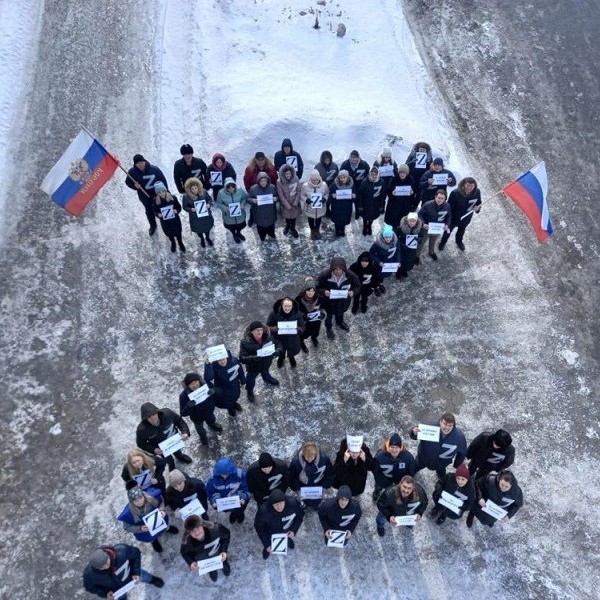Disputes on the Language Front
In the lead-up to the U.S. presidential elections of 2020, it seemed like word usage and language were always in the news. What perfect timing for launching a museum of words, I thought. But since 2020 that focus hasn’t diminished — not in the U.S. and certainly not now in central Europe. With Russia’s invasion of Ukraine, a flood of news stories about words and language is sharing equal billing with news coming from the battlefront and bomb shelters.
But whereas I felt well-equipped to understand and evaluate language issues arising around the election and its aftermath — for instance, whether there were alternative facts or whether the events of January 6 were properly labeled a popular protest or an insurrection — I didn’t feel as confident about judging the language stories I kept hearing from Russia and Ukraine, so I did some research.
The Linguistic Landscape in Ukraine
Ukrainian was declared the national language in 1991 when Ukraine won its independence from the Soviet Union. During its years as a Soviet Republic, Russian had been widely used but not enforced on Ukrainians until after Russification laws imposed by Stalin.
Many surveys have tried to accurately count how many Ukrainians speak Russian and use Russian in their everyday life and vice versa. In a country of 44 million people, according to a Washington Post article on Feb. 8, 2022, today “about half the population speaks mostly Ukrainian at home and about 30 percent speak mostly Russian in their households, with the rest speaking both or other languages such as Hungarian, Romanian and Crimean Tatar.”
In 2014 with the Maidan uprising, there was already a boost in popular support for the Ukrainian language, especially among youth. Then in 2019 a new Language Law was adopted by the Ukrainian Parliament, which ruled that Ukrainian would be used in media and the internet, in all public and government institutions, in schools, and in certain industries. The capital city is now referred to as Kyiv, the more accurate Ukrainian transliteration from the Cyrillic, rather than the Russian transliteration, Kiev. But speaking of Cyrillic, the Ukrainian alphabet is not identical to the Russian one, even though they both are largely based on Cyrillic letters. The two languages share a lot of features, but there are differences in everything from pronunciation to writing to vocabulary, with a 38% difference in vocabulary according to the Ukrainian Lessons website.
In the lead up to the present war, the Russian government claimed that Russian-speaking citizens were being oppressed by the Ukrainian government, echoing similar claims by the Russians prior to their 2014 annexation of Crimea. However, as reported in an article by the Atlantic Council, “the politicization of language does not reflect the day-to-day reality of bilingual Ukraine, where both Russian and Ukrainian are commonly spoken and widely understood across the country.” Indeed, President Volodymyr Zelensky is himself a native Russian speaker.
Sources I checked reported that Ukrainian tends to dominate the western regions of the country, while Russian tends to prevail in Eastern and Southern Ukraine. Russian also tends to be the dominant language in urban areas except in Western Ukraine, while Ukrainian is spoken more in villages. However, people often use both languages in the same conversation, and there is a colloquial mix of Russian and Ukrainian known as Surzhyk that is often heard in rural areas where formal Russian or Ukrainian is often less perfected or taught.
So it’s certainly a complicated picture, but both languages (and others, such as Crimean Tatar) seem to be accepted and used almost interchangeably.
For more information on Ukrainian and Russian language see this recent blog post by the scholar team at Duolingo.
The Russian Propaganda Machine
But there’s another language issue dominating coverage of the conflict that isn’t such a simple matter and as easily understood: the total shutdown of the press and the inability of journalists in Russia to factually report the news. When the use of certain words is made a crime punishable by 15 years in a Russian jail, as Moscow decreed on March 4, it’s unrealistic to expect reporters to continue doing their work according to usual professional standards. But as was the case with book-banning work-arounds, in the 21st-century it’s silly and ultimately futile to try to prevent the news from getting out. People have so many alternative ways to find out what’s going on and aren’t dependent, if they choose not to be, on just tuning in to state-run and approved media. As reported recently in the Washington Post, people can set up VPN (virtual private network) accounts to get news over the internet, or even connect to the internet via an Elon Musk SpaceX satellite.
But even if sources of news, presumably unbiased, are available to those seeking it, skepticism and doubt about news that doesn’t align with the Kremlin’s narrative, are being sowed. Propaganda methods little seen since Soviet days are being used to support the Russian government’s line. What we are seeing and hearing is a textbook definition of propaganda: “the dissemination of information — facts, arguments, rumors, half-truths, or lies — to influence public opinion” but revved up for the internet and social media age in a country where factual reporting has been criminalized and fact-checking made difficult. Democracy and truth are under assault.
Ukrainians report that their family members in Russia don’t believe them when they tell them that Russia is bombing civilian targets or that Russia has invaded a country that was at peace (and not overtaken by Neo-Nazis, as Putin has declared). Chillingly, the letter Z, symbolizing the Russian military (but written more like the number 3 in Cyrillic), has been seen scrawled across military vehicles and was even worn by a Russian gymnast on the medal podium during a competition in Qatar. Shades of another symbol used to galvanize the citizenry during a previous European war?

Z-symbol Flash Mob at Omskoblvodoprovod, Omsk. Вечерний Омск – Неделя. Портал Администрации города Омска, CC0, via Wikimedia Commons
All of these dangerous manipulations of words (and even script) should raise great concern for everyone. We couldn’t agree more with an opinion piece by Jay Caspian Kang that appeared in the New York Times this week that we need to double-down in efforts to teach news literacy to young people — from an early age. That is a skill that can be taught, and has been successfully taught in Finland and even tiny Estonia. At Planet Word, we partnered with the News Literacy Project to develop our interactive “beacon” on the subject, and we will be designing a virtual field trip curriculum around that subject as well.
As we’re learning when assessing news about everything from COVID-19 vaccines to global warming to Russian aggression, it’s never too early to start reading critically, investigating sources, and asking probing questions. And we have the tools and sources to do so — a bright side of the internet era — where the whole world is watching.
—Ann Friedman, founder of Planet Word



